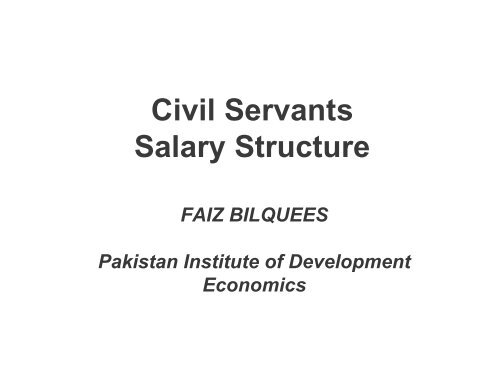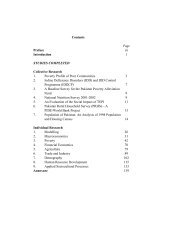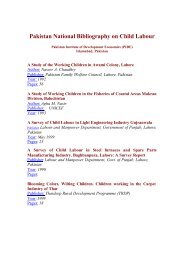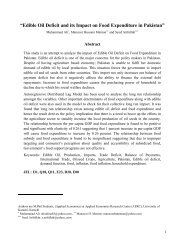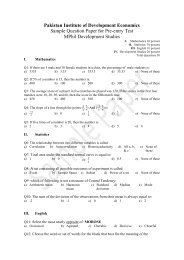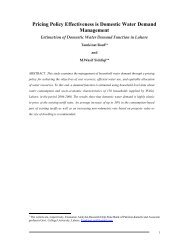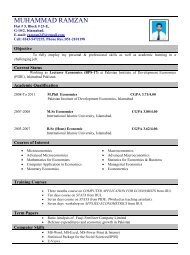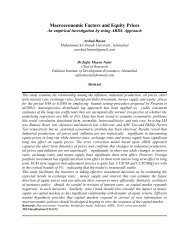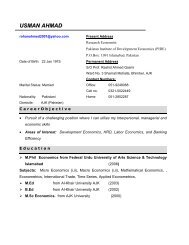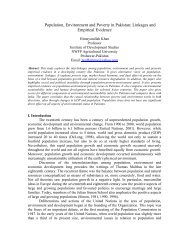Civil Servants Salary Structure - Pakistan Institute of Development ...
Civil Servants Salary Structure - Pakistan Institute of Development ...
Civil Servants Salary Structure - Pakistan Institute of Development ...
Create successful ePaper yourself
Turn your PDF publications into a flip-book with our unique Google optimized e-Paper software.
<strong>Civil</strong> <strong>Servants</strong><br />
<strong>Salary</strong> <strong>Structure</strong><br />
FAIZ BILQUEES<br />
<strong>Pakistan</strong> <strong>Institute</strong> <strong>of</strong> <strong>Development</strong><br />
Economics
Guiding principles <strong>of</strong> the salary<br />
structure in <strong>Pakistan</strong><br />
! The salary structure <strong>of</strong> <strong>Pakistan</strong> can be<br />
classified as the “rank-in-man” category<br />
! The principle underlying civil servant salary<br />
in <strong>Pakistan</strong> has been summarized as,<br />
“overall narrowing <strong>of</strong> the salary structure and<br />
provision <strong>of</strong> a living wage to the lowest paid<br />
employees.”
Guiding principles <strong>of</strong> the salary<br />
structure in <strong>Pakistan</strong> (contd.)<br />
! On the issue <strong>of</strong> wage parity between government employees<br />
and other sectors the 1949 Pay Commission headed by Justice<br />
Munir, when discussing the principles for determining civil<br />
service pay in <strong>Pakistan</strong>, noted that: “ We do not think it to be a<br />
right policy for the state to <strong>of</strong>fer such salaries to the servants as<br />
to attract the best available material. The correct place for our<br />
men <strong>of</strong> genius is in the private enterprise and not in the<br />
humdrum <strong>of</strong> public service where character and a desire to<br />
serve honestly for a living is more essential than outstanding<br />
intellect. We cannot therefore prescribe our pay scales with<br />
the object <strong>of</strong> attracting to public service all the best intellect in<br />
the country.”
The Pay Scales<br />
! The pay structure comprises <strong>of</strong> twenty-two<br />
basic pay scales (BPS) adopted by the<br />
1972 <strong>Civil</strong> Services Reform Commission.<br />
! These scales favour the higher grades<br />
both in terms <strong>of</strong> the ratio <strong>of</strong> highest paid to<br />
the lowest paid as shown in Table I.
The Pay Scales (contd.)<br />
The absolute difference between the<br />
minimum salaries <strong>of</strong> grades 1-10 remains<br />
less than one hundred rupees, except for<br />
grade 9.
Length <strong>of</strong> the pay scales<br />
! The length <strong>of</strong> the pay scales is reflected in the<br />
number <strong>of</strong> stages to reach the maximum <strong>of</strong> the<br />
scale as shown in table 1.<br />
! The stages in achieving the maximum <strong>of</strong> a<br />
scale in the 1991 and 1994 pay awards have<br />
been doubled from 15 to 30 stages in 2001<br />
and 2005 for grades 1-16, increased by more<br />
than half for grade-17, doubled for grades 18<br />
and 19, and increased by less than half for<br />
grades 20-22 compared to that in the nineties.
Length <strong>of</strong> the pay scales (contd.)<br />
! The long pay scales are inefficient and uneconomic.<br />
! However the long scales are desirable considering<br />
that shorter scales would require rapid promotions<br />
as too many people would be stagnating at the<br />
maximum <strong>of</strong> the scale.<br />
! This implies that prospects for promotion influence<br />
the length <strong>of</strong> scale and the expansion <strong>of</strong> pay scales<br />
from 15 to 30 stages is perhaps due to insufficient<br />
posts in all the grades.
Length <strong>of</strong> the pay scales (contd.)<br />
! It is important to note however that besides the<br />
annual increments career advancement requires<br />
a reasonable number <strong>of</strong> promotions as one<br />
works his/her way through the career path.<br />
! For every job there is a given time span, within<br />
which an individual becomes the most efficient<br />
worker, and beyond that diminishing returns<br />
start to set in.
Length <strong>of</strong> the pay scales (contd.)<br />
! A person on the same job for 15 or more years<br />
with no prospects <strong>of</strong> improvement in his living<br />
insight is bound to lose all motivation to work<br />
over the coming years, consequently, the<br />
correlation between the length <strong>of</strong> service and<br />
performance may fall to zero and then turn<br />
negative.<br />
! The continued payment <strong>of</strong> increments in this<br />
scenario would be unacceptable under the rankin-post<br />
structure. The rank-in man system <strong>of</strong><br />
civil service accepts it as a compensation for the<br />
person-element, length <strong>of</strong> service.
Overlapping <strong>of</strong> pay scales<br />
Scales overlap when the maximum <strong>of</strong> one scale<br />
is higher than the minimum <strong>of</strong> the next higher<br />
scale(s). In principle, in the advanced<br />
industrialized countries federal service salary<br />
scales do not overlap by more than two higher<br />
scales.
Overlapping <strong>of</strong> pay scales (contd.)<br />
! Table III shows that the lowest 6 grades overlap by<br />
10-11 grades while the top four grades overlap by<br />
1-3 grades.<br />
! Between grades 7 to 18 overlapping worsened or<br />
remained constant over the period 1991-2005.<br />
! The overlapping <strong>of</strong> scales permits staff in lower<br />
grades to earn the same salary as personal in<br />
higher grades. Thus overlapping <strong>of</strong> scales<br />
undermines the linkage between pay and work.
Increments<br />
! Since the civil service involves a life long<br />
career with the government it is considered<br />
obligatory to provide regular increments to the<br />
employees to enhance their earnings with<br />
rising age and family responsibilities,<br />
regardless <strong>of</strong> any change in duties.<br />
! Secondly it is believed that these increments<br />
contribute to efficiency and help retain<br />
experienced workers.
Increments (Contd.)<br />
! Generally an increment has to be earned by<br />
way <strong>of</strong> crossing some efficiency bar but in<br />
<strong>Pakistan</strong> the 1983 Pay Commission abandoned<br />
the clause <strong>of</strong> efficiency bar on the grounds that<br />
it was not observed, and increments have since<br />
been granted virtually automatically with some<br />
exceptions.<br />
! This automatic grant <strong>of</strong> the increments without<br />
consideration to performance obviously has<br />
adverse effects on motivation and efficiency<br />
compared to when it is earned.
Increments (contd.)<br />
! <strong>Pakistan</strong> has one flat rate per scale and no<br />
efficiency bar to be crossed, therefore as an<br />
employee moves along the scale his percentage<br />
increase in salary from successive increments<br />
falls when we consider increments as a percent<br />
<strong>of</strong> basic salary.<br />
! This is contrary to the situation in 1972, 1977,<br />
and 1981 pay scales when the flat sum was<br />
raised after an intermediate level had been<br />
reached. An efficiency bar always had to be<br />
crossed in the form <strong>of</strong> a satisfactory special<br />
report on performance to receive the larger sum.
The regular allowance structure<br />
(Housing)<br />
! Housing facility to the federal government<br />
employees falls into three categories; i) those<br />
who make their own living arrangements<br />
instead <strong>of</strong> renting house on government<br />
account and get 50 percent <strong>of</strong> the basic salary<br />
as housing subsidy; ii) those who requisite<br />
houses in the open market according to the<br />
rental ceiling allowed by the government for<br />
each grade; and iii) those who are provided<br />
government accommodation.
Housing (Contd.)<br />
! House rents have been increased four times at a<br />
declining rate over the period 1991-2005 as<br />
shown in Table IV.<br />
! In section c <strong>of</strong> Table IV it is interesting to see that<br />
grouping together <strong>of</strong> grades for house rent has a<br />
serious anomaly, the higher salary results in<br />
lower house rent entitlement upto grade 18.<br />
! This erosion has serious implications for the very<br />
poor households in the lowest grades, indeed it<br />
looks very awkward for grades seventeen and<br />
eighteen.
House Rent<br />
! House rent is still the most valuable cash allowance<br />
for employees renting houses, but this facility pales<br />
in comparison to the physical government housing.<br />
! Grade-22 <strong>of</strong>ficer renting his own house or any house<br />
at the <strong>of</strong>ficial entitlement in Islamabad gets<br />
Rs.16,962/- but the government house, for the same<br />
grade has an imputed rental value <strong>of</strong> around<br />
Rs.200,000 in any sector <strong>of</strong> Islamabad.<br />
! It is an open secret that many people in top positions<br />
live in government housing while their own houses<br />
(generally in the name <strong>of</strong> spouses) are rented out at<br />
market rates.
Conveyance Allowance<br />
! The absolute amount <strong>of</strong> conveyance allowance, its<br />
rate <strong>of</strong> increase over time, and the allowance as<br />
percentage <strong>of</strong> basic salary for all grades are shown<br />
in Table V (a, b, c).<br />
! As in case <strong>of</strong> house-rent when calculated as a<br />
percent <strong>of</strong> the basic salary this practice results in<br />
losses to employees <strong>of</strong> higher grades. The loss is<br />
particularly more pronounced between grades 16-<br />
20. This practice <strong>of</strong> lumping grades for house rent<br />
and conveyance allowances is rather ambiguous.
Conveyance Allowance (contd.)<br />
! The conveyance facility <strong>of</strong> grade 21-22 for <strong>of</strong>ficial<br />
and private use includes tax free cars <strong>of</strong> 1000 and<br />
1300cc respectively; fully indexed fuel <strong>of</strong> 180 and<br />
360 litres per month, full maintenance and repairs,<br />
as well as uniformed drivers. It will be seen from<br />
Table 6 that in 2005-06 only the fuel payments add<br />
up to 50 and 94% <strong>of</strong> the basic salaries <strong>of</strong> the two<br />
grades respectively.
Grade-Specific Allowances<br />
! The grade-specific allowances include Washing<br />
allowance for employees in Grades 1-4; and<br />
Entertainment allowance, Senior post allowance,<br />
and Orderly allowance for Grades 20-22.<br />
Entertainment allowance has also been granted to<br />
grade-19 in the last pay revision.<br />
! Orderly Allowance was introduced in 1985-86 and<br />
was initially admissible only if an orderly for<br />
domestic duties was actually hired. This was meant<br />
to promote employment <strong>of</strong> lower-income groups.<br />
However, this condition was waived later and<br />
Orderly Allowance is now part <strong>of</strong> the salary.
Real Wages 1990/91 to 2005/06<br />
! The revision <strong>of</strong> salaries in June 1991 resulted in<br />
higher real wages for all grades in 1991/92 but<br />
in the next year all grades above 10, except for<br />
13, faced erosion in their real salaries.<br />
! The July 1994 revision led to gains for grades<br />
11-15 also but beyond that real wages <strong>of</strong> all<br />
grades declined. However the gainers were<br />
reduced to grades 1-4 in the next year (1994-<br />
95).
Real Wages 1990/91 to 2005/06<br />
! Despite the 7% cost <strong>of</strong> living allowance in July<br />
1999 real wages for all grades declined.<br />
! The adhoc relief <strong>of</strong> Rs.300 to grade 1-16 in<br />
March 1997 resulted in gains for grades 1, 2 and<br />
4 (grade 3 may be loosing on account <strong>of</strong> clubbed<br />
house rent and conveyance allowance). Real<br />
wages <strong>of</strong> all grades continued to decline in the<br />
next two years.<br />
! The 25% special additional allowance for grades<br />
1-16 and 20% for grade 17-22, in July 1999<br />
resulted in an increase in real salary for grade 1<br />
while that <strong>of</strong> grade 2 was constant.
Real Wages 1990/91 to 2005/06<br />
(contd.)<br />
! Before looking at the salary revision <strong>of</strong> 2001, it<br />
is important to point out that such massive<br />
erosion in real salaries was due to persistent<br />
double digit inflation from 1991/92 to 1996/97<br />
(between 11-13% except for 1991/92 when it is<br />
9%).<br />
! The revision <strong>of</strong> salaries in 2001 by and large<br />
resuscitated only grades 1, 2 until 2005, and<br />
for only two years real salary <strong>of</strong> grade 4 also<br />
increased.
Real Wages 1990/91 to 2005/06<br />
(contd.)<br />
! Finally the revision <strong>of</strong> 2005 (July) showed<br />
gains for grades 1-4 (with the exception <strong>of</strong><br />
grade 3) and grade 22 only. The latter may<br />
be explained by the exceptionally high<br />
increase in the senior post and entertainment<br />
allowance for the highest grade.<br />
! Overall the position <strong>of</strong> almost all grades<br />
deteriorated after 1994-95 with minor<br />
exceptions.
Conclusion<br />
! There are serious anomalies in the present pay<br />
structure and in the allocation <strong>of</strong> cash and inkind<br />
benefits.<br />
! Lengthy, overlapping pay scales with automatic<br />
payment <strong>of</strong> increments weaken the linkage<br />
between pay and work.<br />
! The grant and allocation <strong>of</strong> allowances has its<br />
own ambiguities leading to serious distortions in<br />
remunerations among grades.
Conclusion (contd.)<br />
! Indeed this system <strong>of</strong> perks has many<br />
drawbacks.<br />
! Although the paper shows a decline in real<br />
wages for almost all grades after 1994/95<br />
(except for grade 22 in 2005) certain caveats<br />
need to be noted with respect to the highest<br />
grades.
Conclusion (contd.)<br />
This calculation <strong>of</strong> salaries <strong>of</strong> two<br />
highest grades does not account for all<br />
the perks in detail. For example, it<br />
includes only the price <strong>of</strong> petrol<br />
entitlement <strong>of</strong> one car <strong>of</strong>ficially allowed,<br />
and we cannot account for the unlimited<br />
use <strong>of</strong> telephone at residence for the<br />
highest grade.
Conclusion (contd.)<br />
Moreover it is a common practice by the<br />
top bureaucrats to get themselves posted<br />
as heads <strong>of</strong> public corporations and as<br />
board members <strong>of</strong> local and international<br />
financial institutions where perks,<br />
particularly in-kind, are enormous. If all<br />
such elements could be captured the real<br />
salaries <strong>of</strong> the higher grades would always<br />
be very high.
Costing <strong>of</strong> the two highest grades<br />
Conservative Scenario<br />
Basic min<br />
salary<br />
Monthly<br />
Petrol<br />
entitleme<br />
nt<br />
Driver's<br />
pay<br />
excludin<br />
g Cost <strong>of</strong><br />
Uniform<br />
and<br />
overtime<br />
Average<br />
Monthly<br />
maintena<br />
nce <strong>of</strong><br />
car<br />
Token<br />
Tax<br />
Monthly<br />
house<br />
rent<br />
entitleme<br />
nt<br />
Grade<br />
specific<br />
allowanc<br />
es<br />
Total/mo<br />
nth<br />
Residenc<br />
e<br />
telephon<br />
e facility<br />
per<br />
month<br />
Relief<br />
Allowanc<br />
e<br />
Total/mo<br />
nth<br />
Total<br />
allowanc<br />
es<br />
Total<br />
Allowanc<br />
es as %<br />
<strong>of</strong> basic<br />
salary<br />
Total<br />
Monthly<br />
<strong>Salary</strong><br />
BPS 21, May 2006<br />
18,750.00<br />
9,482.00<br />
5,673.00<br />
2,500.00<br />
29.00<br />
14,174.00<br />
4,275.00<br />
4,620.00<br />
6,930.00<br />
47,683.00<br />
254.31<br />
114,116.00<br />
BPS 22, May 2006<br />
20,055.00<br />
18,965.00<br />
5,673.00<br />
3,500.00<br />
29.00<br />
16,962.00<br />
4,950.00<br />
Unlimited<br />
7,412.00<br />
57,491.00<br />
286.60<br />
135,037.00
Conservative Scenario<br />
These estimates need to be adjusted for:<br />
Lease payments <strong>of</strong> cars per month<br />
Imputed rent per month for government housing for these two<br />
grades.<br />
The monthly lease payments with 10% mark-up for 3 years<br />
tenure amount to:<br />
Rs.20623/ for 1000 c.c. car.<br />
Rs.45691/- for 1300 c.c. car<br />
The imputed rent <strong>of</strong> government housing for these grades in<br />
different sectors <strong>of</strong> Islamabad given their location, structure,<br />
accommodation (inclusive <strong>of</strong> orderly accommodation), prompt<br />
delivery service (i.e., maintenance, garbage collection, street<br />
lights, water supply etc.) would fetch Rs.150,000 to 200,000.<br />
Indeed the properly dealers say that whatever sector is shared by<br />
government housing property value in that sector rises fast. 0
Costing <strong>of</strong> the two highest grades<br />
Adjusted Scenario<br />
Basic min<br />
salary<br />
Monthly<br />
Petrol<br />
entitleme<br />
nt<br />
Driver's<br />
pay<br />
excludin<br />
g Cost<br />
<strong>of</strong><br />
Uniform<br />
and<br />
overtime<br />
Average<br />
Monthly<br />
mainten<br />
ance <strong>of</strong><br />
car<br />
Token<br />
Tax<br />
Monthly<br />
house rent<br />
entitlement<br />
Grade<br />
specific<br />
allowan<br />
ces<br />
Total/m<br />
onth<br />
Residenc<br />
e<br />
telephon<br />
e facility<br />
per<br />
month<br />
Relief<br />
Allowan<br />
ce<br />
Total/m<br />
onth<br />
Monthly<br />
lease<br />
payments<br />
for cars<br />
Total<br />
allowanc<br />
es<br />
Total<br />
Monthly<br />
<strong>Salary</strong><br />
BPS 21, May 2006<br />
18,750.00<br />
9,482.00<br />
5,673.00<br />
2,500.00<br />
29.00<br />
200,000.00<br />
4,275.00<br />
4,620.00<br />
6,930.00<br />
20,623.00<br />
47,683.00<br />
272,882.00<br />
BPS 22, May 2006<br />
20,055.00<br />
18,965.00<br />
5,673.00<br />
3,500.00<br />
29.00<br />
200,000.00<br />
4,950.00<br />
Unlimited<br />
7,412.00<br />
45,691.00<br />
57,491.00<br />
306,275.00
Adjusted Scenario<br />
The adjusted scenario is still not “fully adjusted” because<br />
some things still remain unaccounted for:<br />
! Do the <strong>of</strong>ficers strictly adhere to the use <strong>of</strong> only one car<br />
at all times both for <strong>of</strong>ficial and private.<br />
! For the highest grade what would be the possible<br />
‘limits’ to the unlimited use <strong>of</strong> residence telephone.<br />
! The emoluments and perks received/earned by being<br />
member <strong>of</strong> boards <strong>of</strong> different national and international<br />
corporations and financial institutions.
Recommendations<br />
! The only way out <strong>of</strong> this maze <strong>of</strong> existing salary<br />
structure is to monetize all the perks at the market<br />
rate and add to the basic wage fully indexed. This<br />
begs the question: how to determine the salaries<br />
after that?<br />
! Government in industrialized market economies<br />
have generally taken the level <strong>of</strong> pay in other<br />
employing sectors as the basic point <strong>of</strong> reference<br />
when determining the remuneration <strong>of</strong> their<br />
employees.
Recommendations (contd.)<br />
Paying the civil servants at the same<br />
rate for the job as private companies,<br />
and sometimes public enterprises as<br />
well, is considered fair to employees, to<br />
tax payers and to the government as an<br />
employer who wants to attract, and<br />
retain a motivated staff to work<br />
efficiently.
Recommendations (contd.)<br />
! Although wage parity for <strong>Pakistan</strong>i civil<br />
servants was ruled out in 1949 by Justice<br />
Munir Pay Commission, however in the<br />
present day world it is evident that intelligent<br />
managers are the need <strong>of</strong> the civil service.<br />
Only right people in the right places can put<br />
this distorted corrupt and inefficient structure<br />
back in place.<br />
! All recommendations to this effect have so far<br />
been brushed aside on the pretext <strong>of</strong> lack <strong>of</strong><br />
resources?
Recommendations (contd.)<br />
The three possible avenues available are:<br />
! Privatize all government housing and cars, rent<br />
out at market rates, or sell out all government<br />
structures as well as land given at very<br />
subsidized rates to the persons in top positions.<br />
! It is high time we as a nation started looking at<br />
things in the long run perspective: the<br />
improvement in the long-run productivity due to<br />
salary increases will start paying up for the initial<br />
expenditures undertaken.<br />
! Avail the donor resources on civil service reforms.


